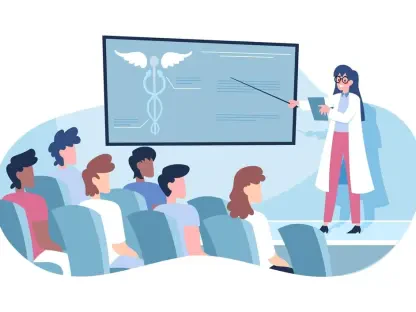Telehealth has emerged as a revolutionary approach in healthcare, offering numerous benefits, particularly in emergency and disaster care. By merging high-tech solutions with medical needs, telehealth promotes eco-friendly practices while enhancing the efficiency and accessibility of emergency medical services. This article explores how telehealth is playing a critical role in transforming healthcare delivery during emergencies, reducing environmental impact, and improving patient outcomes.
Reduction in Carbon Footprint
In the quest to decrease its carbon footprint, the company has implemented several strategies to reduce emissions and enhance sustainability. These initiatives include transitioning to renewable energy sources, implementing energy-efficient practices, and promoting sustainable transportation methods for employees.
Decreased Travel Emissions
Telehealth significantly reshapes healthcare delivery by reducing the necessity for in-person visits, which in turn minimizes travel-related emissions. Patients can consult with healthcare providers from the comfort of their homes, eliminating the need for car trips, which are a major source of carbon dioxide emissions. By decreasing travel, telehealth not only benefits the environment but also saves time and resources for both patients and healthcare providers, contributing to a more sustainable healthcare system. The decreased travel translates into reduced road congestion, fewer traffic accidents, and lower carbon emissions, collectively easing the environmental burden.
The substantial impact on emission reduction cannot be overstated. Traditional healthcare systems often require patients and medical personnel to commute frequently, which contributes to high carbon footprints. Telehealth leverages technology to bridge distances, making medical consultations accessible with just a few clicks. This advancement is particularly beneficial in metropolitan areas, where daily commutes can significantly contribute to urban air pollution. As telehealth becomes more integrated into everyday medical practice, the cumulative reductions in travel-related emissions will markedly decrease the healthcare sector’s carbon footprint.
Lower Energy Consumption in Medical Facilities
In addition to mitigating travel emissions, telehealth also contributes to lower energy consumption in medical facilities. By shifting a significant portion of healthcare services to virtual platforms, telehealth reduces the operational demand on hospitals and clinics. These facilities require substantial energy to operate, from lighting and heating to the perpetual powering of medical equipment. The transition to virtual care means fewer patients need to visit in person, leading to reduced lighting, heating, and cooling needs in waiting rooms and consultation areas, thereby slashing the energy requirements of these medical establishments.
The energy conservation achieved through telehealth is a major step towards achieving sustainable healthcare. Each virtual consultation means less dependency on physical infrastructure, thus lowering the operational costs and environmental impact associated with running large healthcare facilities. Hospitals and clinics can thus function more efficiently, focusing resources where they are needed most. Moreover, this reduced energy consumption aligns with the broader global efforts to reduce carbon emissions and combat climate change, positioning telehealth as a key player in sustainable healthcare reform.
Minimized Medical Waste and Resource Use
Reduction in Physical Medical Resources
A pivotal benefit of telehealth is its sharp reduction in the need for physical medical resources. During virtual consultations, the usage of disposable gloves, gowns, bandages, and other single-use items is significantly decreased, directly resulting in less medical waste. This is particularly relevant as healthcare facilities globally are striving to adopt more sustainable practices, and cutting down on medical waste is a primary objective. The reduction in the consumption of these materials also alleviates the burden on supply chains and reduces the environmental impact associated with their production and disposal.
Telehealth’s capacity to diminish medical waste contributes profoundly to the environmental aspects of healthcare delivery. Fewer physical resources equate to less non-biodegradable waste ending up in landfills or incineration facilities, which ultimately translates into a cleaner and healthier environment. Moreover, this shift supports the circular economy model within healthcare, fostering sustainability by reducing resource input and minimizing waste output. Telehealth’s resource efficiency thus aligns with both environmentally conscious practices and healthcare cost management, forming a symbiotic relationship benefiting both sectors.
Lower Infrastructure Demands
The infrastructure required for the effective delivery of telehealth services is considerably less than that for traditional healthcare facilities. Virtual care platforms do not necessitate extensive physical space, medical equipment, or large staffing bodies as traditional facilities do. This reduction in physical infrastructure demands translates into lower overall resource consumption, which further promotes eco-friendly practices within the healthcare system. Hospitals and clinics can thus dedicate more space and resources to critical care services instead of expansive waiting areas or diagnostic rooms.
Such a downsizing in infrastructure needs not only reduces the ecological footprint of healthcare establishments but also offers financial benefits. By lowering the overhead costs associated with maintaining large facilities, healthcare providers can allocate funds more efficiently towards patient care and technological advancements. The lean infrastructure model facilitated by telehealth ensures that medical services remain robust yet resource-efficient, fostering a sustainable healthcare ecosystem. The emphasis on optimizing resource use aligns with global sustainability goals, reinforcing telehealth’s role in environmentally responsible healthcare delivery.
Improving Accessibility and Reducing Disparities
Bridging Healthcare Gaps
Telehealth has emerged as a powerful tool in bridging healthcare gaps, particularly for rural and underserved populations. These communities often face significant barriers to accessing medical care, including long travel distances and limited availability of healthcare providers. Telehealth effectively overcomes these challenges by providing remote consultations, ensuring that patients receive timely medical attention regardless of their location. By democratizing access to healthcare, telehealth is instrumental in leveling the playing field for underserved communities, granting them access to quality medical care that was previously out of reach.
The increased accessibility of healthcare services through telehealth is transforming the landscape of medical care for rural areas. Residents no longer need to travel long distances for routine check-ups or specialist consultations, which was often a considerable barrier to receiving timely care. The deployment of telehealth means that even those in the most remote areas can access expert medical advice, preventive services, and follow-up care without the logistical challenges of traditional healthcare visits. This enhanced accessibility not only allows for improved health outcomes but also fosters trust and reliability in the healthcare system among underserved communities.
Enhancing Public Health
Telehealth’s role in making healthcare more accessible contributes significantly to overall public health improvements. Patients can receive regular check-ups, follow-up care, and preventive services without the need for in-person visits, which is particularly beneficial for managing chronic conditions and early detection of diseases. This ease of access reduces health disparities across different demographics and promotes a healthier population, a fundamental aspect of sustainable healthcare. By enabling consistent monitoring and timely medical intervention, telehealth ensures that public health standards are maintained and disease management is more efficient.
This system ensures that healthcare services are not only widely available but also efficiently delivered, resulting in better patient outcomes and satisfaction. The convenience and accessibility of telehealth encourage patients to seek medical attention promptly, reducing the progression of chronic illnesses and preventing potential complications. Moreover, telehealth facilitates coordinated care among different healthcare providers, ensuring comprehensive and continuous care for patients. This integrated approach supports the public health infrastructure by relieving the pressures on traditional healthcare facilities, allowing them to focus on critical cases while maintaining overall public health.
Preemptive Care during Disasters
Remote Consultations for Disaster Preparedness
Telehealth plays a crucial role in providing preemptive care during disasters, enabling patients to seek remote consultations to prepare for upcoming natural events. This includes ensuring they have the necessary medical advice and prescription refills required to endure any disruptions. Such proactive measures help mitigate the adverse impact of disasters on individuals’ health and well-being, ensuring communities are better prepared to handle medical emergencies amidst challenging circumstances. Telehealth thus serves as an indispensable tool in disaster readiness by providing essential healthcare guidance and support before, during, and after a disaster, thereby enhancing community resilience.
This preemptive approach is vital in regions prone to natural disasters, where access to healthcare facilities can be severely disrupted. Patients with chronic conditions or those requiring regular medical oversight benefit immensely from telehealth services that ensure continuity in their care plans. Remote consultations eliminate the anxiety of missing critical medical appointments or running out of necessary medications, offering peace of mind and stability during uncertain times. The ability to access healthcare advice and services remotely ensures that populations are better equipped to face the challenges posed by natural disasters, significantly reducing health risks.
Ensuring Continuity of Care
During disasters, telehealth ensures continuity of care by allowing patients to consult with healthcare providers remotely, a feature that is particularly important for individuals with chronic conditions who require ongoing medical attention. Natural disasters can disrupt access to healthcare facilities, but telehealth bridges this gap by facilitating continuous medical interaction between patients and providers, even when physical access is compromised. By maintaining access to care, telehealth helps prevent health complications and alleviates the burden on emergency services, ensuring that critical resources are available for those in immediate need.
Continuity of care facilitated by telehealth is essential in disaster scenarios, where timely medical intervention can be life-saving. Patients with conditions such as diabetes, heart disease, or mental health issues rely on consistent medical oversight to manage their illnesses effectively. Telehealth offers an uninterrupted care pathway, allowing healthcare providers to monitor and manage patients’ conditions remotely. This constant availability of medical support ensures that patients remain stable and informed, reducing the risk of exacerbations or complications due to lack of care. Telehealth thus plays a pivotal role in sustaining healthcare delivery during crises, safeguarding patient well-being and optimizing emergency response efforts.
Alleviating Strain on Emergency Services
Increasing Capacity for Critical Cases
During disasters, emergency services are often overwhelmed with a high volume of cases, and telehealth helps alleviate this strain by enabling remote consultations for non-critical cases. This increases the overall capacity of emergency services to accommodate patients, allowing healthcare providers to prioritize the most critical cases and improve disaster response efficiency. By handling non-urgent medical issues remotely, telehealth optimizes the use of emergency medical resources, ensuring that those who need immediate physical intervention receive timely and focused care, thereby enhancing the effectiveness of disaster medical response efforts.
The strategic use of telehealth to manage less critical cases remotely supports a more efficient allocation of medical resources during emergencies. This separation ensures that emergency services remain agile and responsive, able to concentrate on life-threatening conditions without being burdened by manageable concerns. Telehealth acts as a triage system, filtering non-critical cases away from physical emergency rooms, thus streamlining the workflow and reducing the overwhelm experienced by emergency medical staff. This optimization of resources directly translates into improved patient outcomes and a more resilient emergency response framework.
Optimizing Resource Use
Telehealth allows for better coordination and prioritization of care, optimizing the use of limited resources and medical supplies during emergencies. First responders can leverage telehealth services to determine which patients require immediate physical interventions and which can be managed remotely, ensuring efficient allocation of resources. This efficiency is essential for effective disaster management, as it maximizes the impact of available medical supplies and personnel, minimizing wastage and ensuring that critical needs are met promptly. By integrating telehealth into emergency protocols, first responders and healthcare providers can enhance their response capabilities, delivering effective care with optimal resource utilization.
In emergency situations, the precise allocation of resources can be the difference between life and death. Telehealth provides a real-time overview of patient needs, enabling healthcare teams to make informed decisions rapidly. This not only ensures that medical supplies are used where they are most needed but also means that staff efforts are directed effectively, preventing exhaustion and burnout among first responders. The enhanced coordination enabled by telehealth leads to a more structured and responsive emergency care system, capable of adapting swiftly to the dynamic demands imposed by crises. Overall, telehealth’s role in resource optimization underscores its importance as a tool for sustainable and effective disaster management.
Mental Health Support
Mental health support is crucial for individuals coping with emotional and psychological challenges. Comprehensive mental health services provide necessary assistance, ranging from counseling and therapy to crisis intervention and medication management. Accessibility to these resources ensures that individuals receive the timely help they need to maintain their well-being and lead fulfilling lives.
Accessible Counseling Services
Disasters often leave traumatic imprints on communities, necessitating mental health support that is both accessible and effective. Telehealth offers a robust platform for providing counseling services, helping individuals cope with trauma without the stigma associated with in-person visits. Licensed professionals can offer remote mental health services, ensuring that those affected by disasters receive the necessary support during critical times. By breaking down barriers to mental health care, telehealth enhances the emotional and psychological resilience of communities, ensuring comprehensive disaster recovery that addresses both physical and mental health needs.
The convenience of telehealth counseling services allows individuals to seek help from the privacy of their own homes, which can significantly reduce the reluctance or embarrassment some might feel about visiting a counselor in person. This accessibility ensures that more people can benefit from mental health support, which is crucial in the aftermath of a disaster. The emotional and psychological well-being of individuals directly impacts their ability to recover and rebuild, making mental health a critical component of holistic disaster relief. Telehealth’s contribution to mental health support ensures a balanced focus on overall well-being during and after disaster scenarios.
Holistic Disaster Relief
Mental health support facilitated by telehealth is as crucial as physical medical attention in ensuring holistic disaster relief. By providing comprehensive care that includes both mental and physical health services, telehealth enhances the overall well-being of affected communities. This approach ensures that all aspects of health are addressed, promoting faster and more complete recovery from disasters. The ability to offer continuous mental health support remotely ensures that individuals can access necessary care throughout the recovery process, reinforcing the stability and resilience of communities facing the aftermath of traumatic events.
Integrated mental health services play a vital role in holistic disaster relief, addressing the multifaceted impacts that disasters can have on individuals and communities. Telehealth platforms enable continuous dialogue between mental health professionals and patients, ensuring that support is ongoing and tailored to individual needs. This continuous care model helps prevent long-term psychological issues and fosters a supportive environment where individuals can openly discuss their experiences. By encompassing mental health in disaster management strategies, telehealth ensures a comprehensive recovery that builds stronger, more resilient communities prepared to face future challenges.
Supporting First Responders
Prioritizing and Coordinating Care
First responders play a vital role in disaster response, and telehealth can significantly support their efforts by enabling improved prioritization and coordination of care. Remote consultations through telehealth allow healthcare providers to assess patients’ needs accurately and direct first responders to those who require immediate attention. This streamlined approach ensures that resources are used efficiently, and patients receive timely care, enhancing the overall effectiveness of emergency response efforts. Telehealth thus acts as a critical tool in augmenting the capabilities of first responders, facilitating a more precise and organized delivery of medical services during disasters.
The ability to prioritize and coordinate care effectively is essential in high-pressure disaster scenarios where time and resources are limited. Telehealth provides a real-time assessment framework that guides first responders, helping them make informed decisions swiftly. This enhanced coordination not only improves patient outcomes but also reduces the risk of resource shortages and misallocations. By leveraging telehealth in their operations, first responders can optimize their response strategies, ensuring that the most urgent cases are addressed promptly while maintaining an efficient flow of care for all patients.
Enhancing Efficiency in Emergency Situations
Telehealth has revolutionized healthcare, especially in emergency and disaster scenarios, by integrating advanced technological solutions with medical care. This innovative approach not only enhances the efficiency and accessibility of emergency medical services but also promotes environmentally friendly practices. Through telehealth, healthcare providers can offer immediate, remote medical consultations and diagnoses, thus improving patient care and outcomes during critical situations. Moreover, the adoption of telehealth reduces the need for physical travel, thereby lessening the environmental footprint of healthcare delivery. This article delves into the significant impact of telehealth on transforming the delivery of healthcare during emergencies, highlighting its role in reducing environmental impact while improving patient outcomes. By leveraging telehealth, the healthcare industry is becoming more adaptable and responsive to emergencies, ensuring timely medical attention and fostering a greener approach to healthcare practices.









